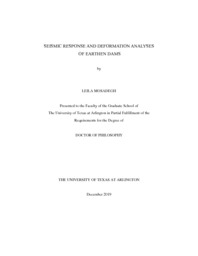
ATTENTION: The works hosted here are being migrated to a new repository that will consolidate resources, improve discoverability, and better show UTA's research impact on the global community. We will update authors as the migration progresses. Please see MavMatrix for more information.
Show simple item record
| dc.contributor.advisor | Puppala, Anand | |
| dc.creator | Mosadegh, Leila | |
| dc.date.accessioned | 2022-02-10T17:29:09Z | |
| dc.date.available | 2022-02-10T17:29:09Z | |
| dc.date.created | 2019-12 | |
| dc.date.issued | 2019-12-05 | |
| dc.date.submitted | December 2019 | |
| dc.identifier.uri | http://hdl.handle.net/10106/30257 | |
| dc.description.abstract | Assessment of the response of earthen structures, such as dams and levees, during earthquake events, is crucially important to geotechnical engineers. It is imperative to perform seismic response analysis to assess the stability and serviceability of these structures during probable seismic events. Before performing a seismic response analysis, an engineer or a researcher needs to select between two-dimensional (2D) plane strain analysis and a computationally intensive three dimensional (3D) analysis of an infrastructure. The 3D analysis should closely capture the behavior of infrastructure seismic response than a simplistic 2D analysis. Furthermore, a dilemma remains regarding the choice of a suitable method to incorporate the effect of the non-linear behavior of geomaterials at different induced strain levels. The non-linear behavior can be incorporated into the analysis using a fully-coupled non-linear method that can capture the soil behavior more accurately as compared to the simple equivalent linear method. However, the calibration of the non-linear models requires extensive high-quality test data, which is seldom available for most projects.
A comprehensive study was planned and formulated to identify the conditions/scenarios which warrant a 3D analysis over a 2D analysis and would require a fully-coupled analysis instead of an equivalent linear type of non-linear analysis. Real and hypothetical earthen dams with widely different geometric configurations and material variabilities were exposed to a broad spectrum of earthquake excitations, and the behavior of the structures was studied using the aforementioned analyses methods. Different parameters such as natural frequency, earthquake-induced accelerations, shear stresses, excess pore water pressure, and post-earthquake deformations are used to evaluate the conditions where the comparatively simple analyses methods can be considered sufficient without incurring appreciable errors.
The estimation of liquefaction-induced lateral deformation of the foundation layers of dams and levees plays a vital role in evaluating the post-earthquake performance of these structures. Post-earthquake deformations are estimated by numerical modeling or using well-known semi-empirical equations that were developed based on real case-history data. A comparative study was performed by estimating the lateral displacements of the downstream foundation of an earthen dam in north Texas. The lateral displacements were computed using both numerical analyses and semi-empirical equations for earthquakes of different magnitudes and peak ground accelerations. The scenarios where both the analyses methods yield similar results were identified, and the post-earthquake performance of the dam was evaluated based on the lateral displacement values.
The findings of this research are expected to facilitate researchers and the geotechnical earthquake engineering fraternity in selecting the appropriate analysis method depending on the characteristics of the site and earthquake scenarios to be used for the analyses. Results suggest that when extensive information is available at the site 3D analysis should be performed and the 2D analysis may overlook potential stability issues of an earthen dam. Also, for dams with dense sand shells experiencing earthquakes with low intensity of excitation, without chances of near-resonance condition, equivalent linear analysis was recognized to show similar results as non-linear method. Furthermore, estimated lateral displacement in the foundation of studied dam was measured to be small and no concern about the stability of this dam was observed. | |
| dc.format.mimetype | application/pdf | |
| dc.language.iso | en_US | |
| dc.subject | Seismic response | |
| dc.subject | Natural frequency | |
| dc.subject | Modes of vibration | |
| dc.subject | Earthen dams | |
| dc.subject | Liquefaction | |
| dc.subject | Lateral displacement | |
| dc.subject | Semi-empirical equation | |
| dc.subject | Numerical analyses | |
| dc.subject | Equivalent linear analyses | |
| dc.subject | Non-linear analyses | |
| dc.subject | Deformation | |
| dc.title | SEISMIC RESPONSE AND DEFORMATION ANALYSES OF EARTHEN DAMS | |
| dc.type | Thesis | |
| dc.degree.department | Civil Engineering | |
| dc.degree.name | Doctor of Philosophy in Civil Engineering | |
| dc.date.updated | 2022-02-10T17:29:10Z | |
| thesis.degree.department | Civil Engineering | |
| thesis.degree.grantor | The University of Texas at Arlington | |
| thesis.degree.level | Doctoral | |
| thesis.degree.name | Doctor of Philosophy in Civil Engineering | |
| dc.type.material | text | |
Files in this item
- Name:
- MOSADEGH-DISSERTATION-2019.pdf
- Size:
- 7.436Mb
- Format:
- PDF
- Name:
- MOSADEGH-DISSERTATION-2019.doc ...
- Size:
- 19.98Mb
- Format:
- Microsoft Word 2007
This item appears in the following Collection(s)
Show simple item record


